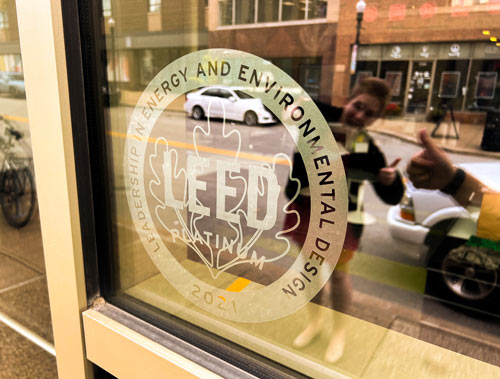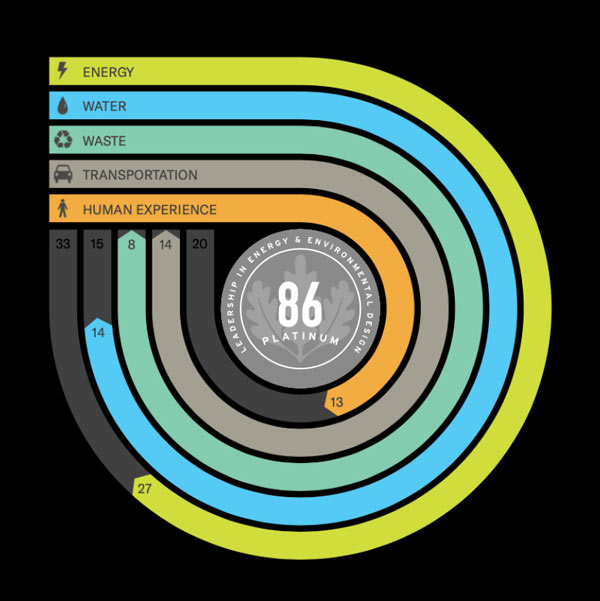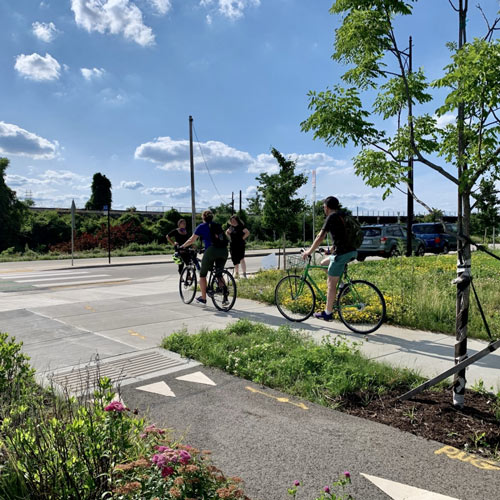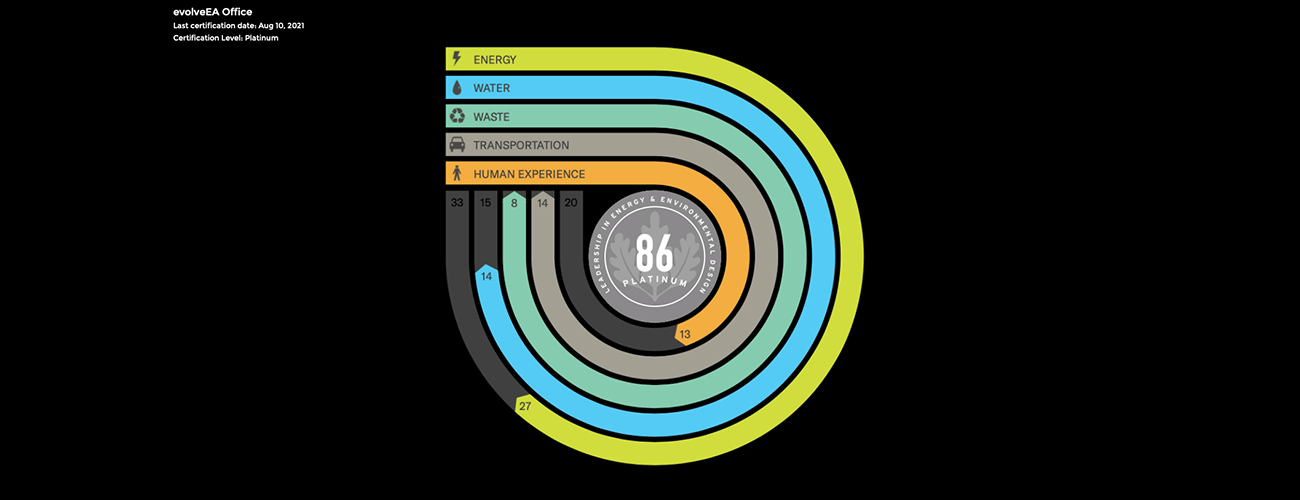evolve’s LEED Platinum Office

LEED Platinum decal on evolve’s office entrance.
evolve continues to be a leader in the green building industry. This time, it is with the operations and maintenance of our own office space in Pittsburgh, PA. Our LEED 4.1 Platinum O+M: Interiors certification of our headquarters is one of three such certifications in the United States, and one of only 14 worldwide.
Nick Rubenstein, project manager for evolve, guided this project through completion. Below, he describes the certification process in depth and shares some tips for how evolve can help your project get certified too.
What makes this certification unique?
NPR: The O+M framework from the USGBC specifically deals with the metabolism of the building. The standard LEED certification that you think of is design-based, so it’s all simulated. The difference between that typical New Construction and O+M, is that rather than it being simulated and based on a designed model, O+M is the actual performance data.
There was a change in the LEED rating system pathways that allowed our certification to happen, too. Previously, the only way you could get O+M certified was through EBOM (Existing Building Operations + Maintenance) which was more for owners and operators of their own space. Then USGBC added a pathway for O+M: Interiors which is better suited for tenants to certify under.
As tenants, we jumped at the chance. We don’t have the opportunity to change our HVAC equipment, but we do have opportunities to reduce our lighting load by using ENERGY STAR equipment, things like that. EBOM had many requirements we simply couldn’t control. So I think they just made it a little more accessible for tenant spaces.
What do you mean when you mention the metabolism of a building?
NPR: That is the input and the output. Any metabolism has both, so there is always going to be some waste product. In our case, the waste product is unused water, greenhouse gases, sewage, and carbon emission. Also landfill waste, which is then linked to greenhouse gases. It’s the intake and then the outtake of the building. It’s the waste generated, the energy utilized, water utilized.
And are you trying to balance them out? Should the inputs and outputs ideally be zero?
NPR: No. You just want to optimize all that. Our small size allowed us to be nimble. That really helped us not only optimize all of these flows, but it also allowed us to optimize them. For example, we were able to put in a 0.35 gallon per minute (gpm) aerator in our water fixtures versus the standard 0.5 gpm. That is a huge savings percentage-wise. That right there gave us 13 out of 15 points for water.
We only have three sources of water: we have our kitchen faucet, we have our bathroom faucet, and we have the bathroom water closet. All three of them are extremely low-flow fixtures, and that’s all we’re using. So it doesn’t matter how many users we get, we’re still saving that percentage of water every time we turn it on. We put in the data and it calculates our score. It’s not just prescriptively simulated to save 30% – we have proof that we are actually saving that amount.

evolve’s Arc Skoru dashboard for LEED Platinum office.
Another cool thing about 4.1 is that it’s very technology-based. Arc Skoru (Arc) is the data management platform that was rolled out when 4.1 was rolled out. You input all your utility bills, your policy data, and then it converts it into a score. It converts everything to a metric ton of carbon equivalency based on your location, based on the number of users in your space. And that’s how you get certified under 4.1.
The automation makes it a little easier. Scores react to changing inputs in real-time, so it’s constantly changing. And you can have pieces of technology connect to Arc through the internet of things.
Part of your Arc score is dealing with the indoor environmental quality of your space. You actually have to measure the values for total volatile organic compounds, carbon dioxide, carbon monoxide, all those things. And so if you have that piece of equipment that is continually testing and putting these values into Arc through the internet of things, your score is being continually updated. So it just makes it seamless, quick, and in some cases the uploads are automated due to these linkages.
What kind of data do you use and what do you look at?
NPR: It’s all boiled down to intensities now and normalized based on square footage and users. For example, water usage intensity is the number of gallons you use divided by square footage and it gives you a gallon per square foot. And that puts the unit of measurement on a base level for comparison with other projects.
Policies are also a big thing. The fact that we are small allowed us to implement policies with ease. I know in some cases with a bigger organization, it’s like trying to steer a ship. When you look into the policies, it’s like turning right; it just takes a while for that turn to actually happen. For us, it was as simple as me writing these new policies. Leadership concurred pretty readily, as we are a B-corp, are Just Certified, and are carbon neutral; so we already practice what we preach. For example, the food that we’re purchasing needs to be 50% organic by cost, purchased computers need to be ENERGY STAR certified, things like that.
Not only is it having an effect on your space, but it’s also pushing the market. The more you’re there, the more you’re purchasing recycled content materials, materials with low VOC, the more the market is going to react to produce those products.
Did you have guidance on what is included in the policies?
NPR: LEED will provide performance thresholds that you have to meet, and then you write those into your business. Like 50% of electronic equipment needs to be EP level law certified. It’s up to us to interpret that. Some of those products we are going to use more, so they’re going to have a direct effect on another metabolite, energy. There are a bunch of different policies and you have to look at them strategically.
Could you describe the process to implement the policies?
NPR: It was really just approval from principals. And then it was thinking about our current situation, how we got here, what materials were used, what systems and processes got us here. And then in the future, thinking what can we be doing differently? Thinking about moving into a new office space played a heavy hand in how we wrote our policies. I would assume if we weren’t moving, there would have been a different process.
You do need buy-in from executive leadership because a lot of this needs to be approved from the top. You need a mandate that says, “We are going to be sustainable. We are getting LEED O+M.” There are so many policies and so many little nuances that relate to the certification. If you needed to get a signature for every little thing you were trying to implement in an organization, it would be very, very difficult. Having that executive mandate would make that process run a little bit smoother. You’re not actually getting into the details of every single policy, rather you’re letting the consultant consult.
Having that vision set from the top, you have to come to terms with that before you decide to get certified. Documenting the metabolism is easy, but really trying to steer the ship is where the work really lies. And it’s not really that much work, most of these best practices are documented. You can take it, it just takes time to implement them.
I imagine the communication piece of that is important too, just to make sure everyone is aware of the policies.
NPR: Yeah. And that’s a good segue. Communication in 4.1 is really important, like when we do our office surveys. One of the big pieces in 4.1 is user feedback, that transparency between facilities, owner-operator, and employees, and building occupants.
Was that not in previous versions?
NPR: Well, no, transparency was not a big part of it. But also, again, a lot of LEED certifications are design-based so you were not working in this space while it was being certified. And so there was not an open channel of communication because there was no other team to communicate with to have that feedback.
Also, sustainability is holistic in nature. We were already Just 2.0 certified, and we’re B Corp certified, and all those social responsibility frameworks play well together. So I guess that could also be a mandate from the top, is, we know that we can and will change policies to walk the walk, to be a sustainable business. I didn’t think it would be a big deal for us to change the policies and it wasn’t because it was already part of the culture.
What were a few areas in which you saw the most impact?

evolveEA team members commute by bicycle to a site visit.
NPR: Our main office is located in a fairly dense, well-connected area in Pittsburgh. It was very intentional. When we were finding a space for the office, we wanted it to be accessible for everyone, and easily accessed by public transit. So the rapid busway station was a big reason why we chose where we did. And we will eventually be moving and this is still the area that we are looking at. And so that gave us an opportunity to get a perfect score in transportation, which is a function of location, but it’s also a function of occupant willingness. To utilize and multimodal transportation and not just use single-occupancy vehicles is a testament to evolve’s policies. We incentivize bicycle commuting, using public transit, things like that.
Did you have to get any new equipment?
NPR: No, that was really when we rented the space out. If you are intentional, it makes things easy and long-term. So when we decided we were getting into this lease, part of the agreement was we are going to choose finishes and fixtures. So we chose all LED lighting. We were able to set up the controllability aspect. Usually, you don’t have a say in your air handler but we were able to get the types of controls we wanted. And so I think being intentional from the outset is a big, big help. And having that negotiation with the landlord. If you don’t control your space, that’s a big part of it.
Have you noticed any connection to increased occupant comfort, productivity, or satisfaction?

evolve team members brainstorm at internal charrette.
NPR: Occupant buy-in is another big thing. You can design, you can have the most efficient systems, you can have low-flow fixtures, but if the occupants don’t use them correctly, it doesn’t matter. So having occupant buy-in for composting or recycling. We did get some pushback for the aerator, but people got over it. Everyone turns off their lights, they will mostly just use the natural light. So having that culture already in place is big. I would assume it would be more difficult if you’re starting from scratch with a culture that is maybe less than sustainable.
It’s like steering the ship. Maybe you have buy-in from the top, or you have that executive mandate and it’s easy to get these policies passed, but still part of turning that ship is getting occupant buy-in. LEED version 4.1 having that big transparency piece and the score being dynamic and having that occupancy feedback survey, that’s all tying in together. That transparency and gamification of it, to see your actions are having real impacts on your sustainability score is a big part of employee buy-in. When you go on the plaque of the Arc dashboard, you’re like, Colors! It’s moving! It’s dynamic. That’s why I wanted to do it.
Do you have any insights on how the ongoing maintenance measures factor into the culture, the process of benchmarking, or moving forward?
NPR: Well, just in general, I think LEED is recognizing that the maintenance operation of a building plays such a big role. Now, if you certify under any pathway in 4.1, whether BD+C, ID+C, etc., you have to recertify every three years under O+M.
That’s another thing that these certifications do well – raising the bar. So you start out with code which is kind of your minimum. Then you have LEED v1 and then, ok, your code is pushed up to that level. Then you have LEED v2, and the code evolves to meet that. If you look at the graph, you can see how code is following the LEED rating system.
Has the way COVID affected us, affected this operating system or other LEED versions, as far as data input, how buildings are used, how occupants use the building? Is spatial distancing a factor? Is air ventilation a factor? How does that affect your operations and maintenance?
NPR: I mean, obviously they’re pushing more air through the building. If you’re using more outdoor air that is more air that you have to condition that is more energy that you’re utilizing. So yeah, there’s a direct correlation. But one thing that they have in 4.1, again, it’s very data-driven and very transparency oriented. And that is what you need to be successful in reentering a building post-COVID. A data-driven transparency base is what Arc was set up for.
What does having this LEED Platinum certification mean for evolveEA?
NPR: We were an early adopter of 4.1. We are the only LEED 4.1 O+M: Interiors project in the state and one of 20 across the country, so we are leading the edge in this process. There was really no other body of knowledge to pull from. We worked closely with our partners at the Green Business Certification Inc. (GBCI), the certifying agency for LEED projects, to get this certification. It was a learning experience for both of us and iterative in that we were providing each other feedback throughout the process.
I think it’s big for evolve and also for Pittsburgh because certifications for existing buildings have been less popular for our clients historically. Existing buildings can sometimes be forgotten. It’s not as flashy to retrofit your existing stock, but that’s also where the most inefficiencies lie. Having 4.1 be super accessible, and evolve actually performing the certification, going through the process, opens up a lot of opportunities for buildings in Pittsburgh to take control of their metabolism. I think the pivot that the industry needs is making it easier to implement sustainable ideals in the existing building stock, and that’s exactly what 4.1 does.
What advice would you give to someone who is looking to do an O+M certification? What would make the process go smoothly?
NPR: Having your utility bills organized ahead of time. If you’re already keeping track of that, that’s perfect. Having an executive mandate from the top, from leadership, saying we want this, we want that. We are aware that there will be policy changes, but that’s not diverting us from the certification.
Having the right equipment. The only really technological piece is testing the air quality. And so you do need to have a piece of equipment with the correct resolution that will test the correct variables down to the correct number of decimals. Let’s say you need to test volatile organic compounds down to one hundred parts per billion. That’s the standard that you have to meet. You can’t just buy a random carbon dioxide sensor off the street, you have to make sure it is measuring to the specified threshold.
How can evolve be of service or help facilitate this process if someone is looking to get an O+M certification?
NPR: We can manage the whole process from providing feedback, doing a gap analysis on current policies, providing feedback on which policies you would have to implement. We can help in organizing the utility bills, documenting all of the building’s metabolites, providing recommendations if you’re not meeting a certain threshold.
We can do a waste audit. We can do indoor air quality testing. We can facilitate occupant feedback surveys. We can manage the utility bills, so energy, water. Implement it into ARC, generate a score.
Looking forward to the future, how do you think this might be relevant? Where do you see the industry going?
NPR: I think the operations and maintenance of the building is the next frontier in sustainability. It’s also low-hanging fruit that has been overlooked since it’s not as flashy. And I think it gives us, again, we’re a small firm, but it gave us the opportunity to be Platinum. Like, sustainable on a platinum level, which is significant if you’re measuring your impact.
Do you have any closing comments that you want to share, favorite parts of the process, or reflections on working on this project?
NPR: My favorite part is just the instant feedback. It used to be such a long review process. And now it’s just, *finger snap* yours. It’s super quick. You could do it, feasibly, in a day, if you had all the policies in place.
The closing thought is, I think it’s a useful framework. I think you’re going to get more value out of it. 4.1 is going to be here for a while. It’s hard, but it’s accessible. You can do it, but you have to want to do it. You have to have that mandate from the top. You have to have employee buy-in and all that kind of has to flow together.
And evolve can help you get it done!
NPR: That’s exactly right.
The Leadership in Energy and Environmental Design (LEED) framework is the global leader in green building standards. It is overseen by the U.S. Green Building Council (USGBC) and certification is approved by a third-party agency, the Green Business Certification, Inc. (GBCI).


